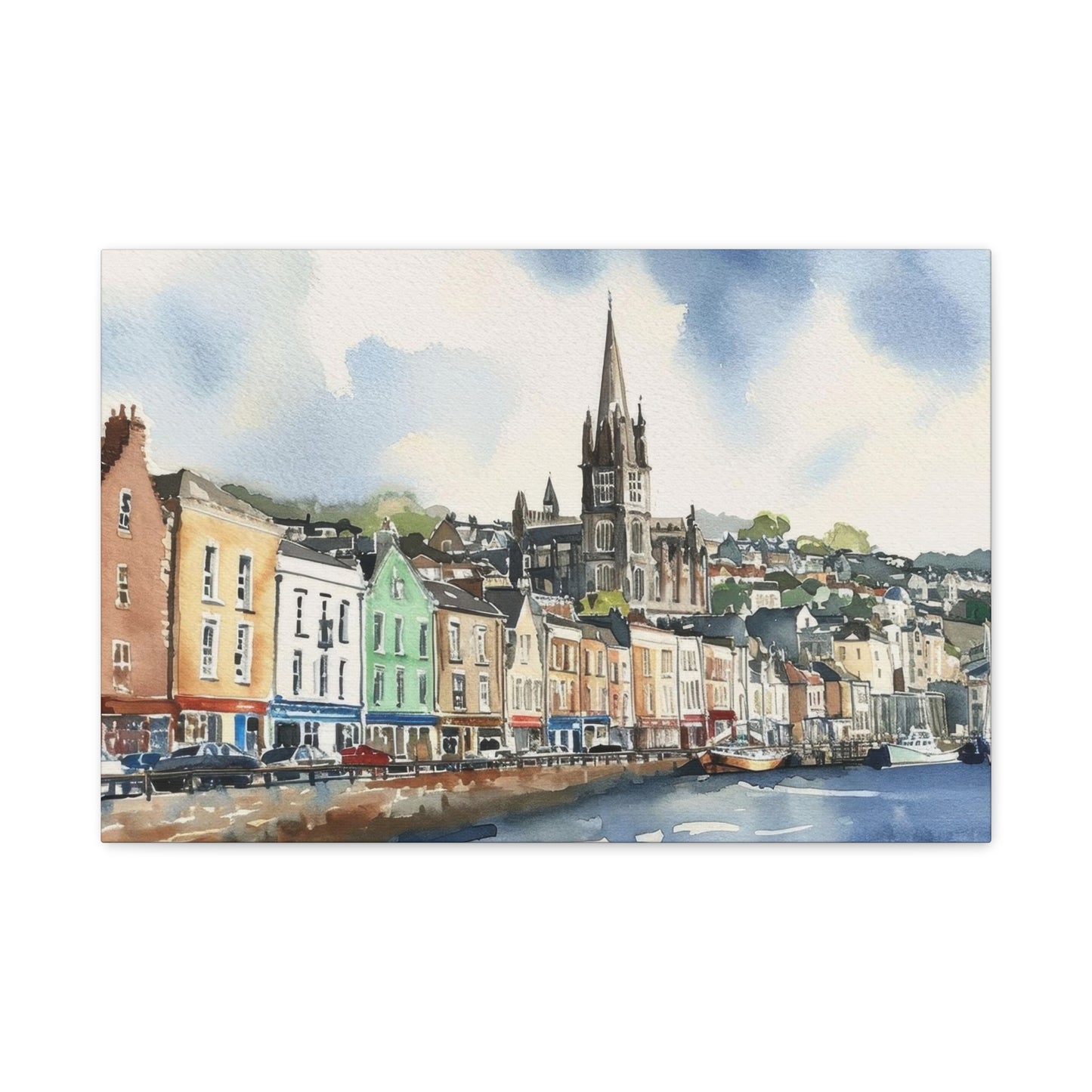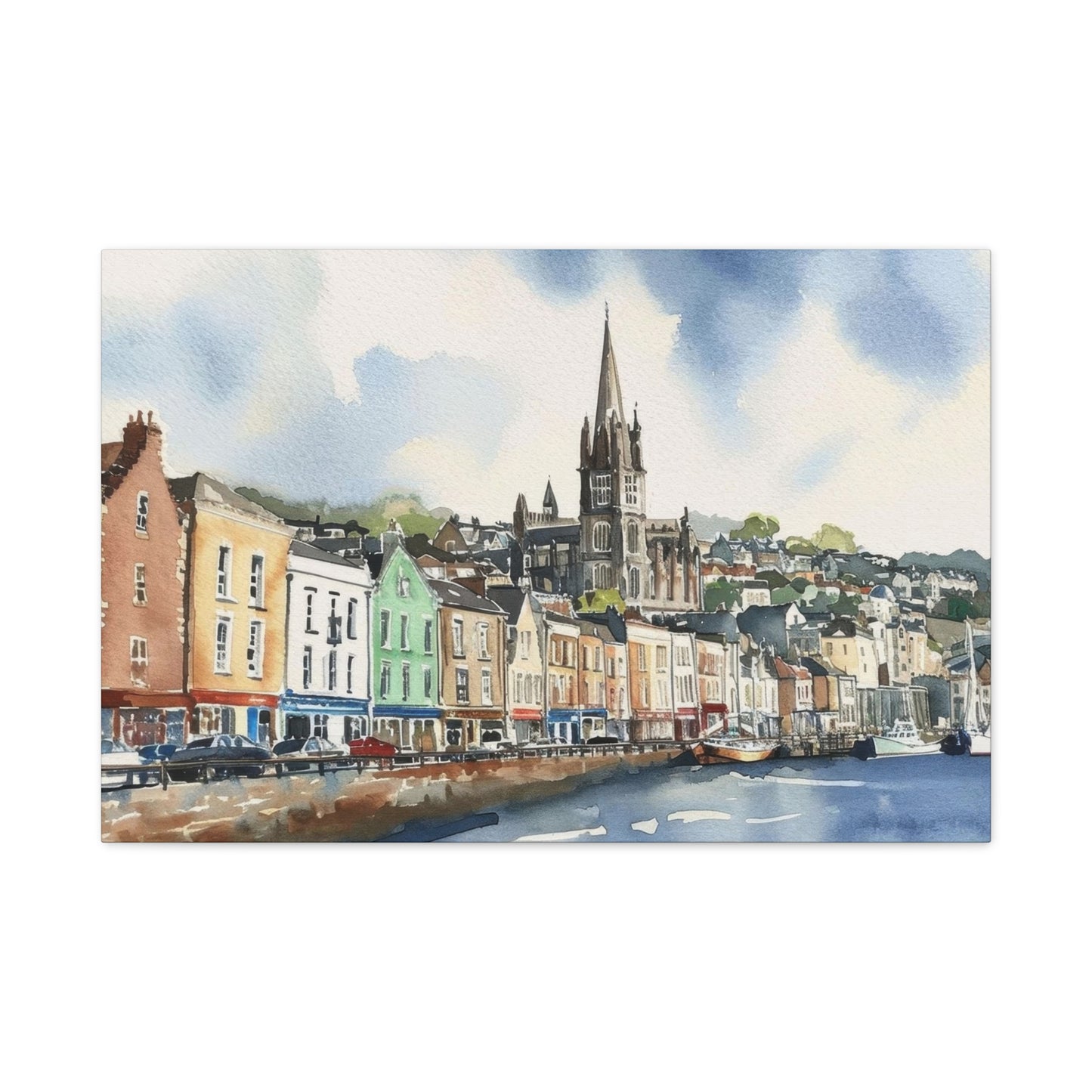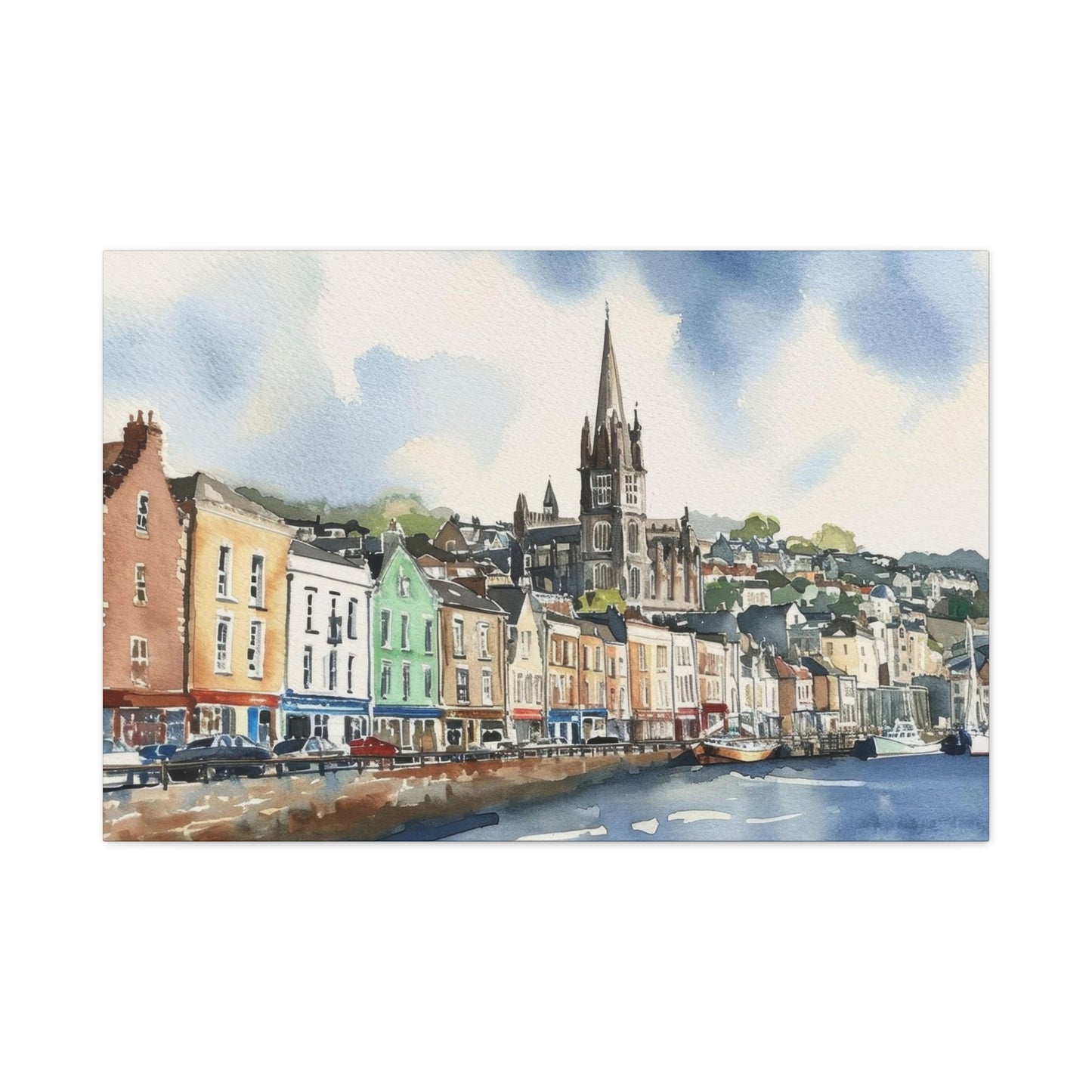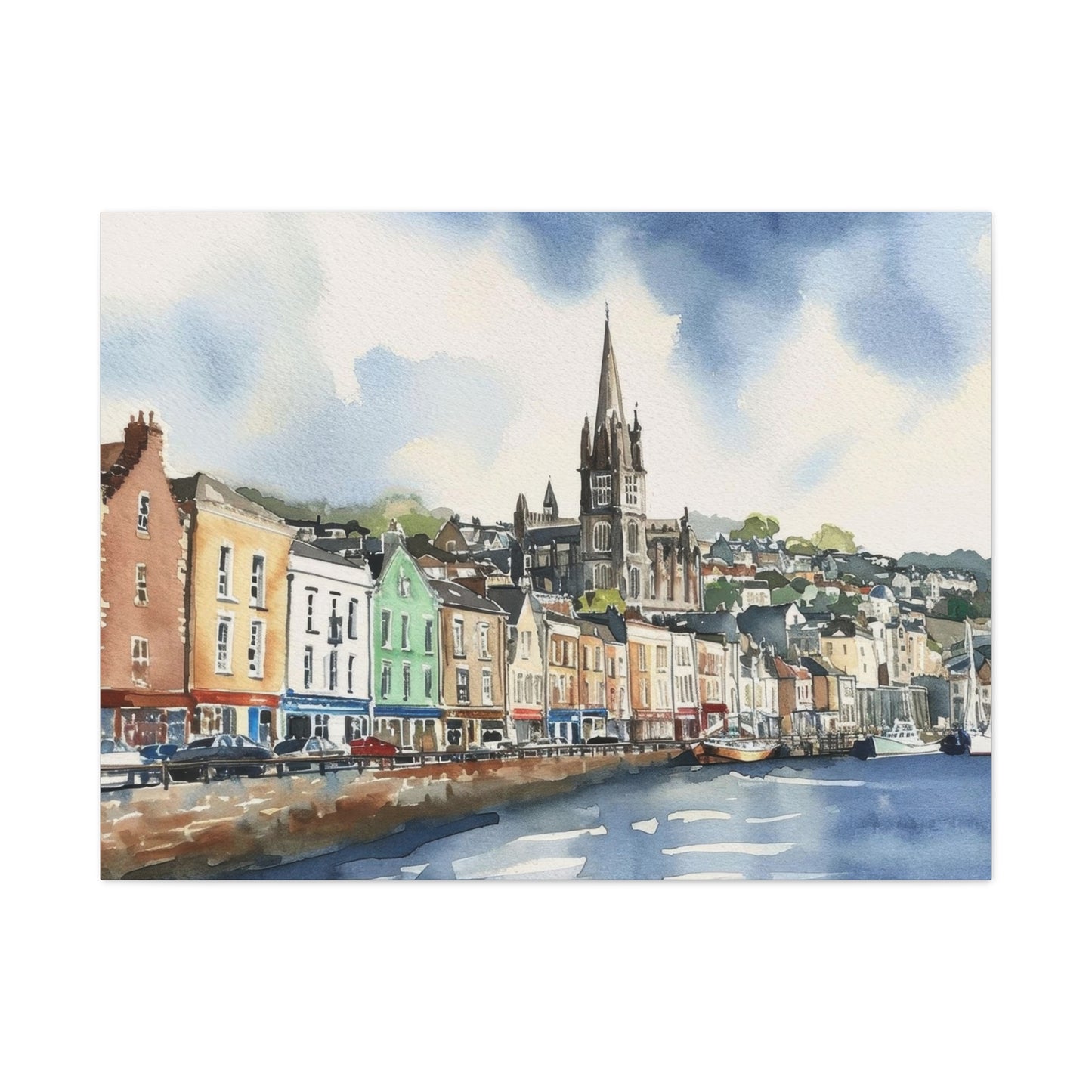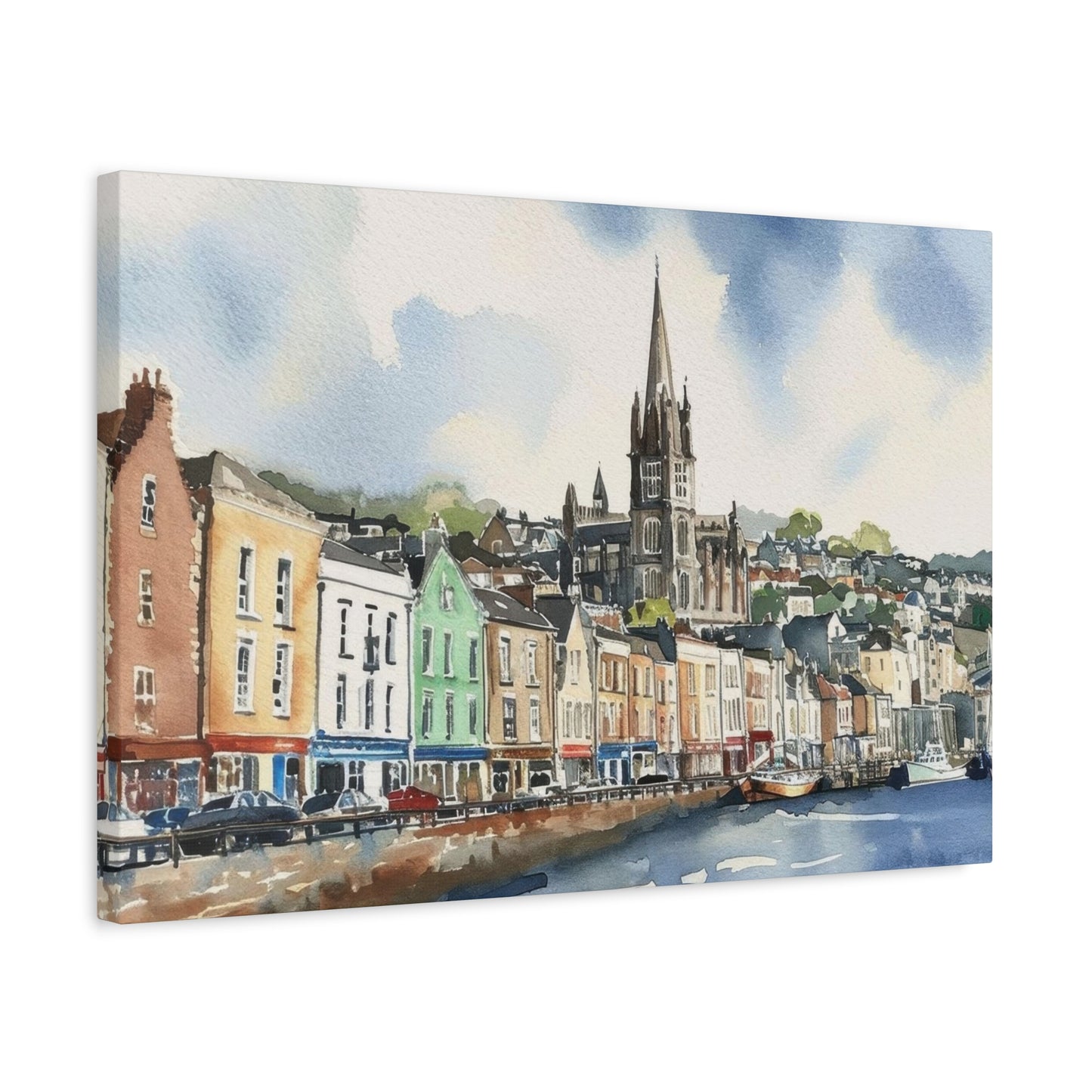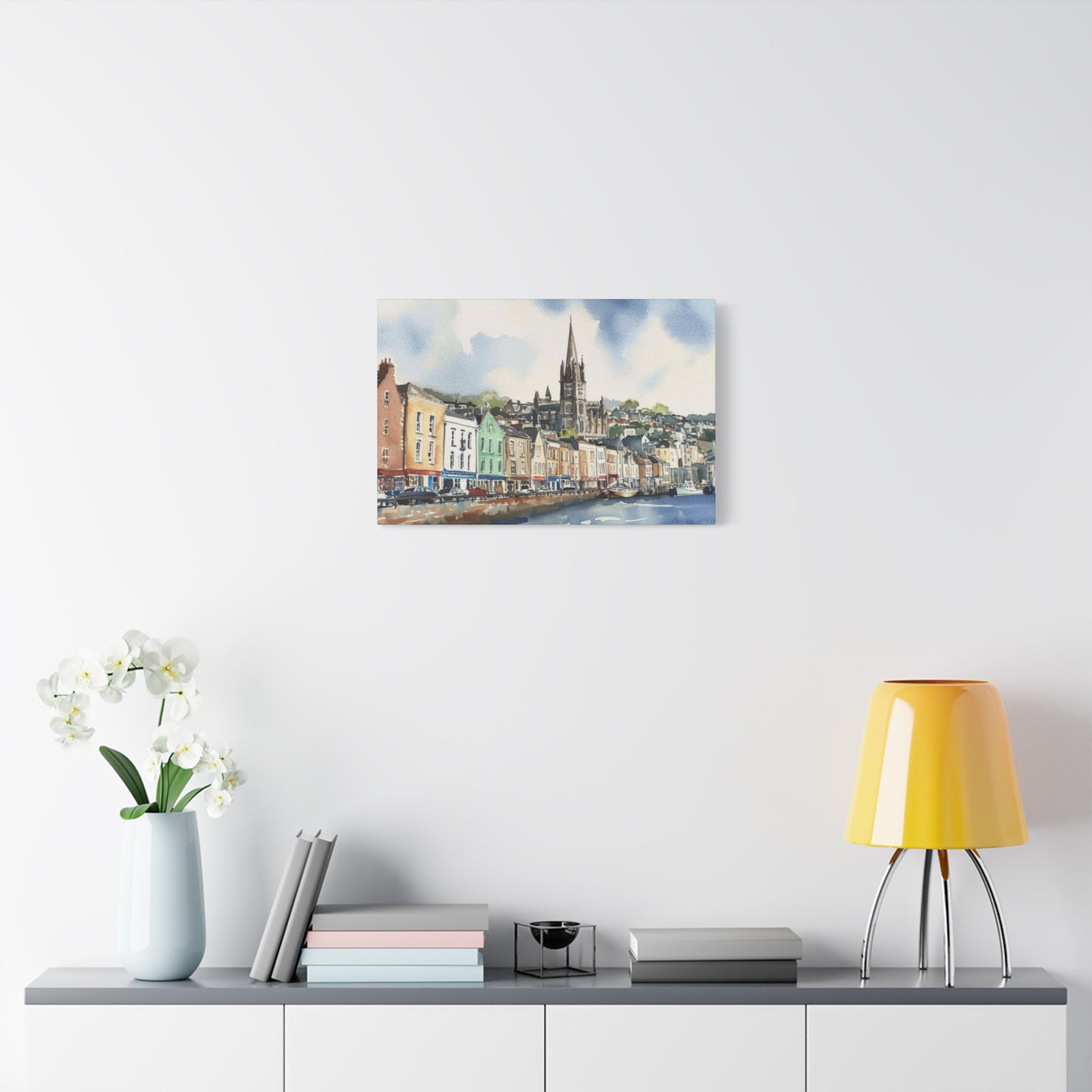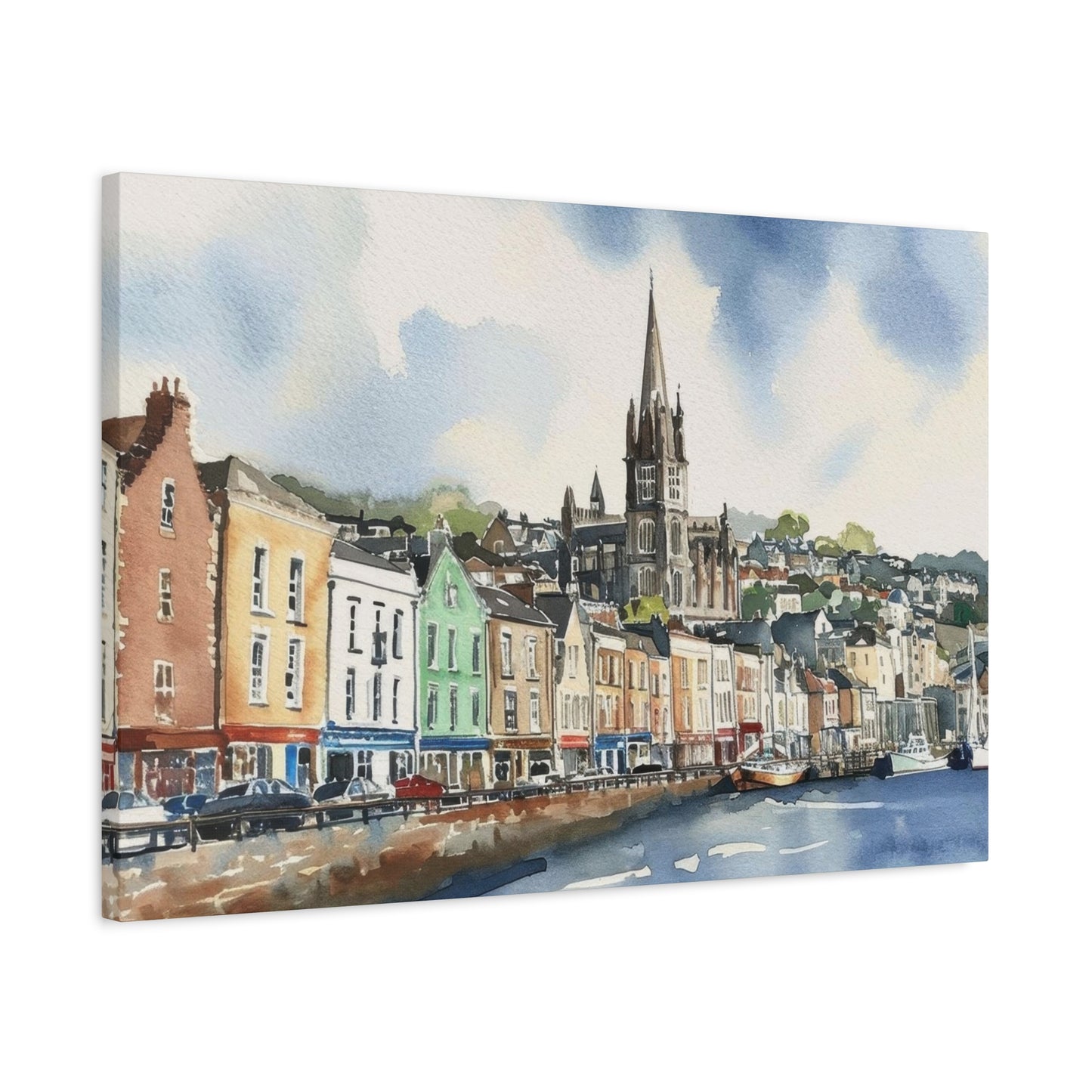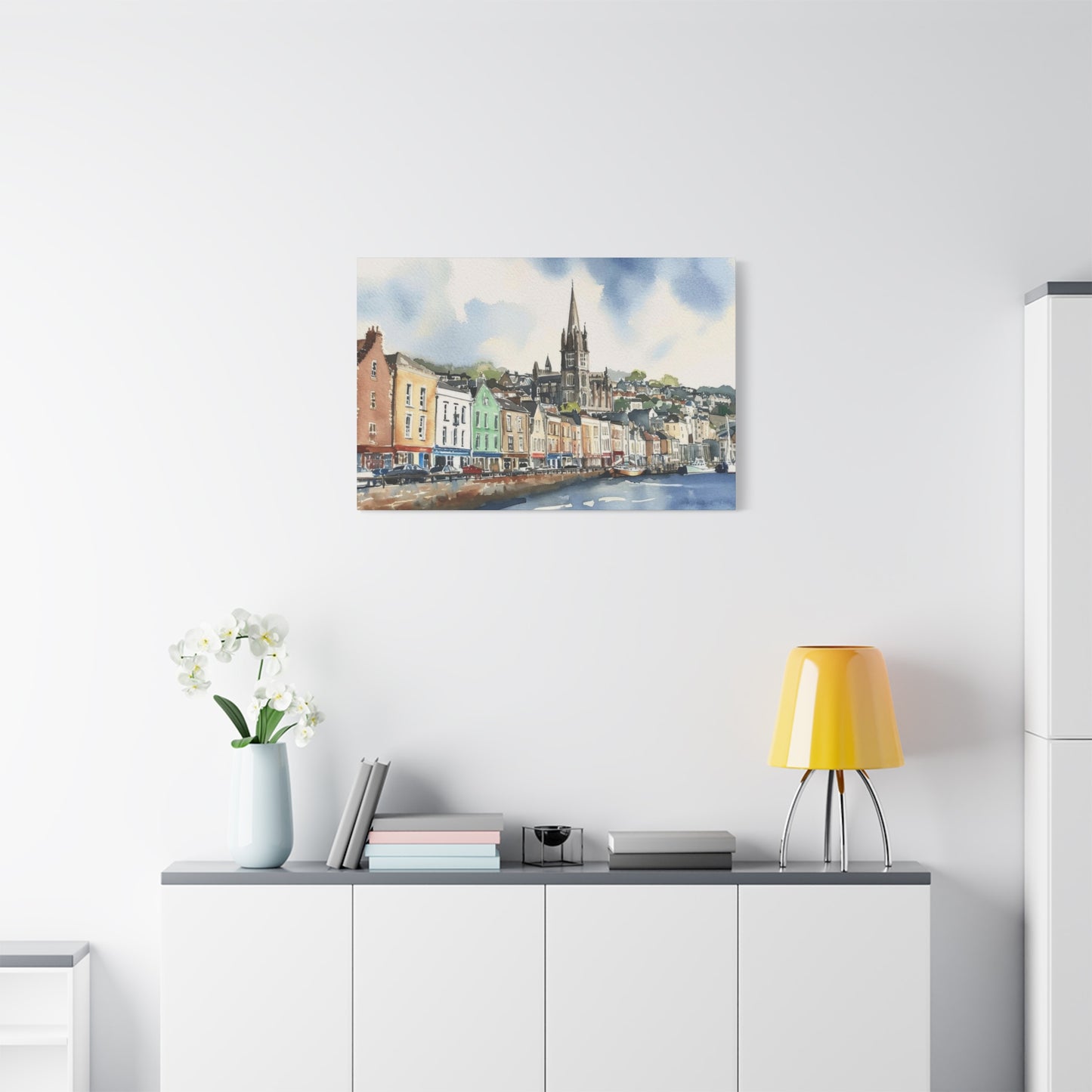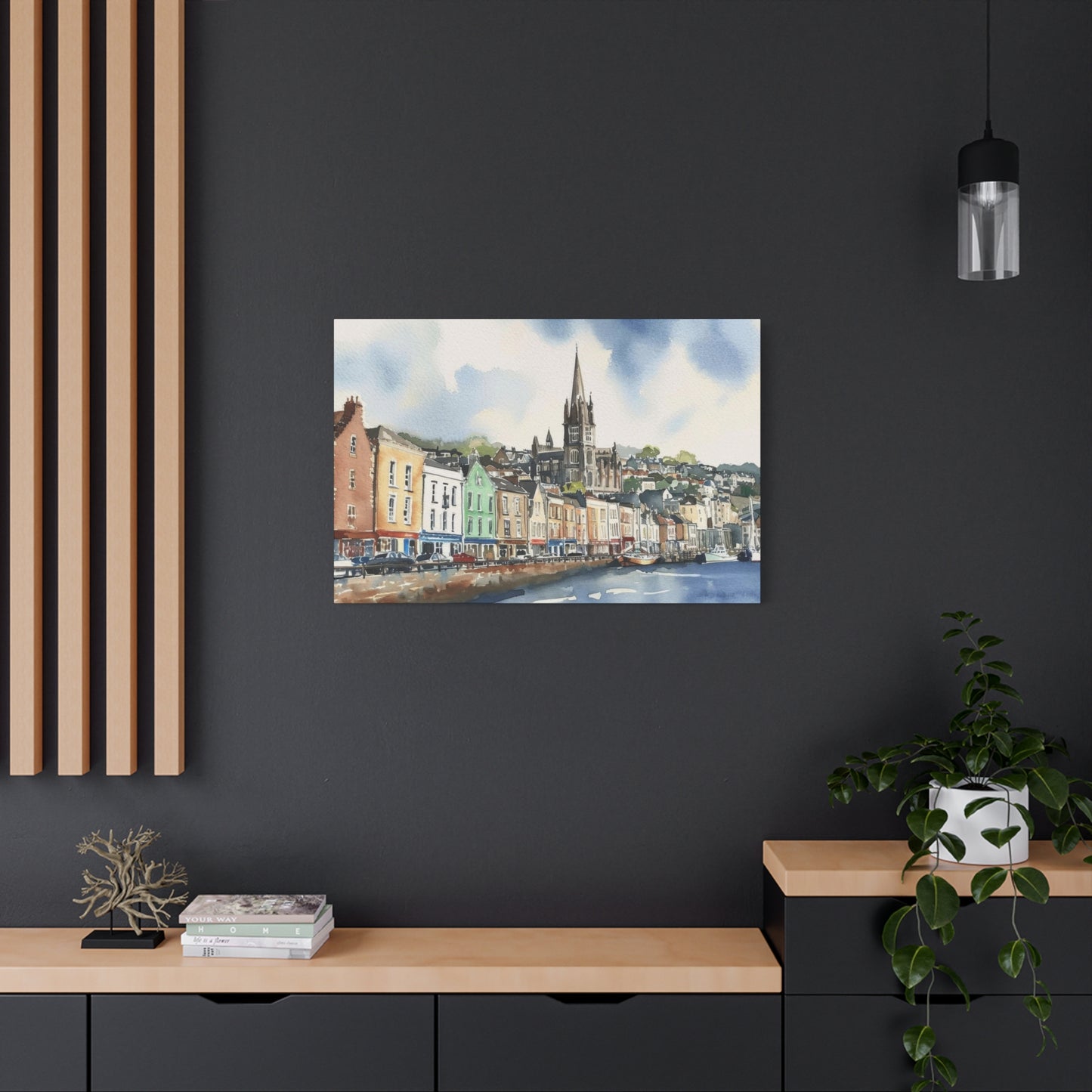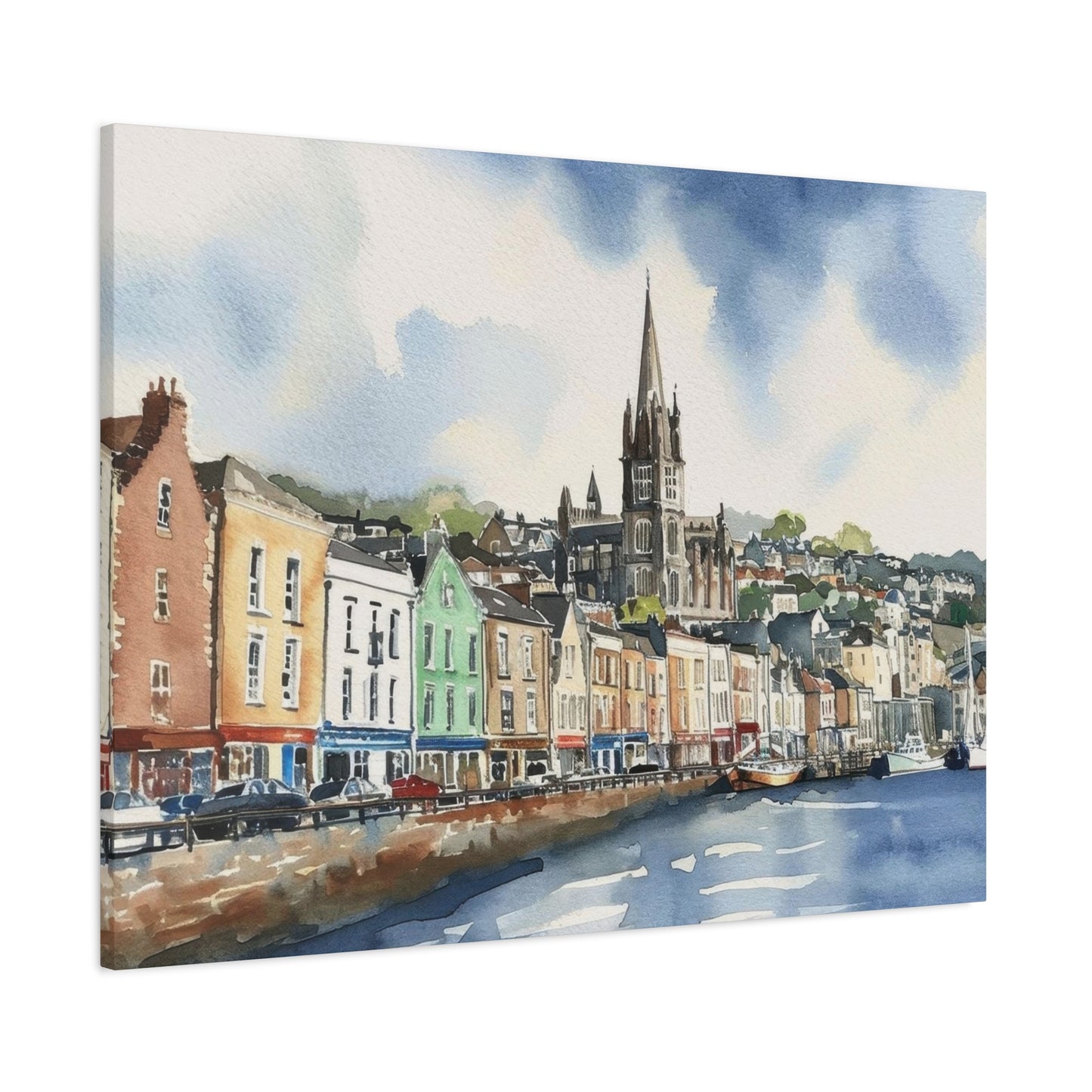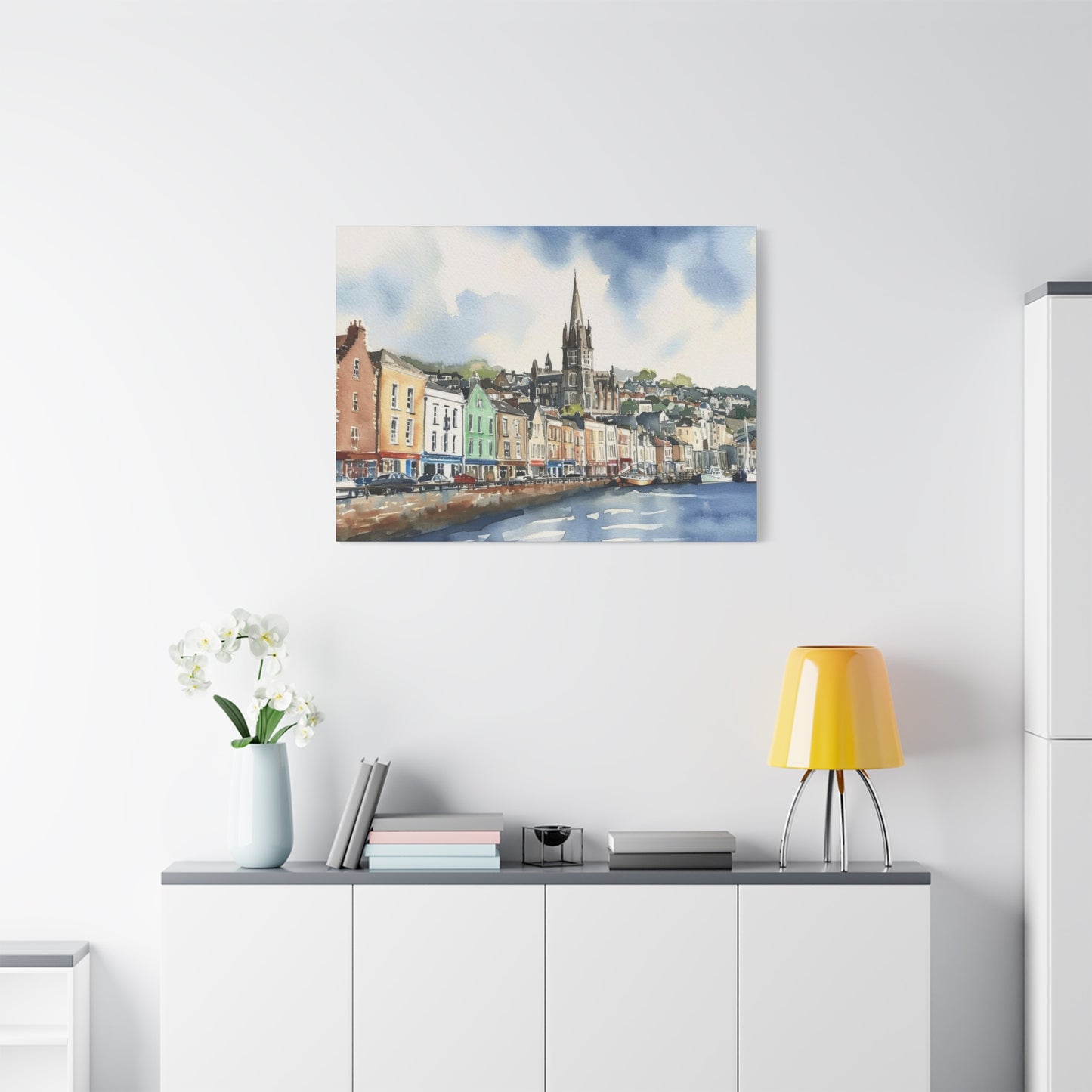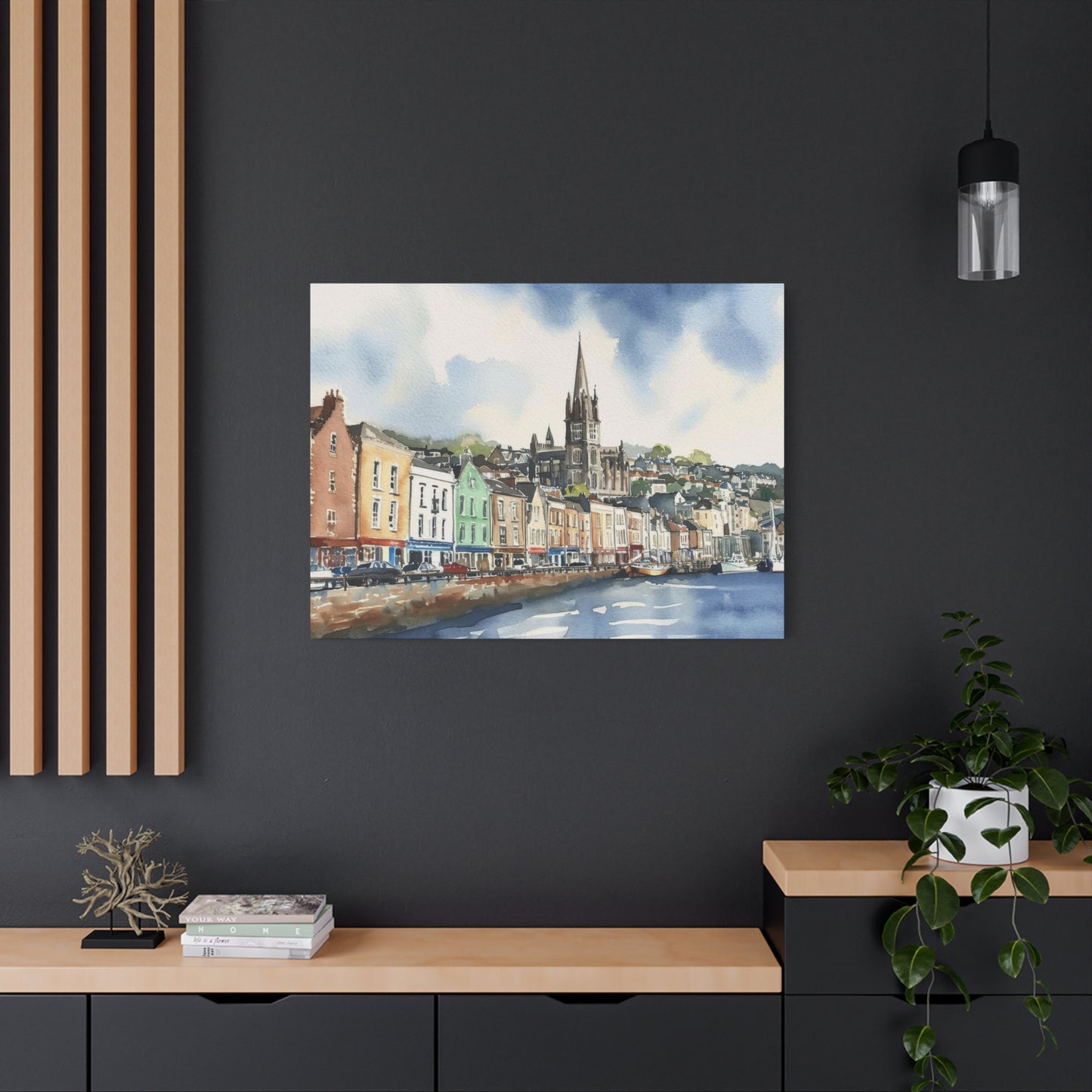Layering Coastal Charm Cobh Ireland Wall Art with Patterns, Textures, and Complementary Prints
The enchanting coastal town of Cobh, nestled along Ireland's picturesque southern shoreline, has emerged as a captivating subject for contemporary wall art and home decoration. This historic maritime settlement, with its distinctive rainbow-colored houses cascading down hillsides toward the shimmering harbor, offers an endless wellspring of artistic inspiration for those seeking to bring the magic of Irish coastal living into their living spaces. The unique architectural character of this waterfront community, combined with its rich seafaring legacy and breathtaking natural surroundings, creates a visual narrative that translates beautifully onto canvas and print media. Artists and photographers from around the world have been drawn to capture the essence of this remarkable location, producing works that celebrate both its vibrant aesthetic appeal and its profound cultural significance.
The resulting artwork serves not merely as decoration but as a window into the soul of Irish coastal heritage, offering viewers a chance to experience the tranquility, romance, and timeless beauty of this extraordinary harbor town. Whether displayed in contemporary minimalist settings or traditional cottage-style interiors, these artistic representations bring warmth, character, and a sense of wanderlust to any environment. The growing popularity of Cobh-inspired wall art reflects a broader appreciation for coastal aesthetics and the desire to incorporate elements of travel, heritage, and natural beauty into personal spaces. Each piece tells a story of maritime tradition, community resilience, and the enduring allure of Ireland's coastal landscapes, making them meaningful additions to homes and commercial spaces alike.
Discovering the Beauty of Cobh Through Canvas Art
The journey of discovering Cobh through canvas art begins with understanding the unique visual elements that make this location so extraordinarily captivating for artistic interpretation. Canvas reproductions and original paintings depicting this coastal treasure offer viewers an opportunity to engage with the location's essence in ways that photography alone cannot achieve. Artists working in various mediums have found that the interplay of light across the harbor waters, the geometric patterns created by the ascending rows of buildings, and the subtle color variations in the painted facades provide endless possibilities for creative expression. The process of translating Cobh's physical beauty onto canvas involves careful attention to the atmospheric qualities that define coastal Irish weather—the soft morning mists that envelope the hillside, the brilliant clarity of afternoon sunshine reflecting off whitewashed walls, and the golden glow of evening light that transforms ordinary structures into something magical.
Canvas art offers texture and depth that enhances the viewing experience, allowing the brushstrokes themselves to become part of the storytelling. Whether rendered in precise realistic detail or interpreted through impressionistic techniques, these works capture something essential about the character of the location. Collectors and art enthusiasts have discovered that Cobh-themed canvas pieces possess a remarkable versatility, complementing diverse interior design schemes while maintaining their distinct identity. The canvas medium brings a sense of authenticity and craftsmanship that resonates with those who appreciate handcrafted quality in their home furnishings. Additionally, the durability and longevity of properly prepared canvas ensure that these artistic investments can be enjoyed for generations, becoming treasured family pieces that carry both aesthetic and sentimental value. The discovery process extends beyond merely viewing the artwork to understanding the historical context, architectural significance, and cultural importance that each piece represents, creating a deeper connection between the viewer and the subject matter.
Colorful Harbors: Cobh Wall Prints for Nautical Homes
Nautical-themed interior design has experienced a remarkable resurgence in popularity, and wall prints featuring Cobh's colorful harbor provide the perfect focal point for spaces embracing this aesthetic direction. The relationship between maritime heritage and home decoration finds its ideal expression in artwork depicting this iconic Irish harbor, where working vessels, pleasure craft, and historic architecture coexist in harmonious visual composition. For homeowners seeking to create authentic nautical atmospheres without resorting to cliched anchors and rope motifs, these harbor views offer sophisticated alternatives that speak to genuine seafaring tradition. The prints capture the essential elements of harbor life—the gentle movement of moored boats, the reflection of buildings in calm waters, the interplay between human construction and natural environment—in ways that evoke both nostalgia and contemporary relevance. Interior designers have increasingly turned to these images as foundation pieces around which entire room schemes can be developed, using the colors present in the prints as inspiration for complementary furnishings, textiles, and accessories.
The versatility of print formats means these works can be scaled and framed to suit spaces ranging from compact powder rooms to expansive living areas, maintaining their visual impact regardless of size. Print technology has advanced to the point where reproduction quality rivals original artwork in terms of color accuracy, detail preservation, and longevity, making these pieces accessible to a broad audience. For coastal property owners, vacation home decorators, and anyone with an affinity for maritime culture, these harbor prints serve as daily reminders of the beauty and romance associated with waterfront living. The imagery speaks to universal themes of journey, homecoming, and the eternal relationship between humanity and the sea, making these prints emotionally resonant beyond their immediate visual appeal. Furthermore, the specific choice of Cobh as subject matter adds layers of historical significance, as this harbor served as the departure point for countless emigrants and travelers throughout history, imbuing the artwork with narrative depth that enriches the viewing experience.
Ireland's Seaside Gem Captured in Art
Ireland's coastline harbors numerous treasures, but few locations possess the concentrated visual appeal and cultural richness found in this particular seaside community, making it an ideal subject for artistic celebration. The process of capturing this gem through various art forms requires sensitivity to the delicate balance between preserving authentic character and creating compositions with broad aesthetic appeal. Artists approaching this subject must navigate the challenge of representing a specific place while creating works that resonate with viewers who may never have visited the location personally. The success of Cobh-inspired artwork lies in its ability to communicate universal themes through specific details—the way morning light touches a particular building facade, the arrangement of boats in the harbor, the relationship between built environment and natural landscape. These elements combine to create imagery that speaks simultaneously to those familiar with the location and those encountering it for the first time through art.
The artistic community has embraced this subject with enthusiasm, producing works that range from meticulously detailed architectural studies to loose, atmospheric impressions that prioritize mood over precision. This diversity of approach ensures that art lovers with varying tastes can find representations that align with their personal aesthetic preferences. The gemlike quality of the location derives not from any single spectacular feature but from the cumulative effect of countless small perfections—the exact shade of a painted door, the curve of a street following the hillside contour, the way multiple architectural styles coexist without conflict. Capturing these subtleties requires not just technical skill but genuine affection for the subject, qualities that distinguish truly exceptional work from merely competent reproduction. The resulting artwork serves multiple purposes: as decoration, certainly, but also as documentation of a specific time and place, as tribute to cultural heritage, and as invitation to viewers to explore Ireland's coastal regions more deeply. In this way, art becomes not just an end in itself but a catalyst for curiosity, appreciation, and deeper engagement with Irish culture and landscape.
The Iconic Cobh Skyline on Canvas
The skyline of Cobh presents one of the most recognizable and photographed profiles along the entire Irish coast, characterized by the soaring spire of the cathedral dominating the ascending rows of colorful houses that march up the hillside from the water's edge. This distinctive silhouette has become synonymous with the town itself, serving as visual shorthand for the location in tourism materials, cultural references, and artistic works. Translating this iconic view onto canvas presents both opportunities and challenges for artists, who must balance faithful representation with creative interpretation to produce works that feel fresh rather than formulaic. The skyline's appeal lies in its perfect composition of vertical and horizontal elements, with the cathedral spire providing a strong vertical anchor balanced by the horizontal bands created by building rows and the harbor waterline. This natural compositional strength makes the skyline inherently suitable for artistic representation, offering built-in visual interest without requiring dramatic manipulation. Artists working with this subject must make decisions about perspective, choosing whether to depict the skyline from water level, from an elevated vantage point, or from various other positions that each offer unique advantages.
The time of day selected for representation dramatically affects the mood and color palette of the work, with dawn, midday, and twilight each providing distinctly different atmospheric qualities. Canvas as a medium proves particularly well-suited for skyline representations, allowing artists to build up layers of paint that create depth and atmospheric perspective, techniques that help convey the three-dimensional reality of the hillside setting. The texture achievable on canvas adds tactile interest that enhances the viewing experience, particularly in works that employ impasto techniques to create physical dimension in sky, water, or architectural elements. Collectors drawn to skyline imagery appreciate the way these works encapsulate an entire location in a single view, providing instant recognition and emotional connection. The enduring popularity of skyline art reflects fundamental human attraction to distinctive silhouettes and landmark views, a psychological response that artists can leverage to create powerful, memorable works. For interior design purposes, skyline compositions offer the advantage of working well in horizontal formats that suit common wall spaces above sofas, beds, and other furniture, making them practical choices for residential and commercial settings.
Vibrant Facades: Artistic Views of Cobh, Ireland
The painted facades of buildings throughout Cobh create a remarkable palette of colors that has inspired countless artistic interpretations, from faithful architectural documentation to wildly imaginative creative interpretations. These exterior walls, rendered in shades ranging from soft pastels to bold primaries, form the visual identity of the town and provide the raw material for some of the most striking artwork associated with the location. The tradition of colorful building exteriors throughout Ireland has both practical and aesthetic origins, with the bright hues serving to combat the sometimes grey maritime weather while creating cheerful, welcoming streetscapes. Artists drawn to these facades find endless variation within what might initially seem like simple subject matter, as the interplay of color, shadow, architectural detail, and weathering creates complex visual textures. The geometric patterns formed by windows, doors, and rooflines provide structural frameworks within which color relationships can be explored and celebrated. Photographing and painting these facades requires consideration of lighting conditions, as the appearance of colors shifts dramatically throughout the day and across seasons.
Morning light brings cool clarity that emphasizes the distinctness of individual colors, while afternoon sun adds warmth that can unify diverse hues into harmonious composition. The slight imperfections in paint application, the variations in surface texture, and the signs of weathering and age all contribute character that prevents the facades from appearing flat or lifeless in artistic representation. Artists must decide how much detail to include, balancing the appeal of architectural specificity against the desire to create works that transcend mere documentation. Some choose to focus on single buildings, treating individual facades as portrait subjects worthy of close examination, while others pull back to show how multiple colored buildings interact to create larger patterns and rhythms. The artistic challenge lies in capturing not just the colors themselves but the feeling they create—the sense of warmth, welcome, and gentle optimism that these painted walls communicate to residents and visitors alike. For art buyers, facade-focused works offer the advantage of strong color that can serve as the foundation for room color schemes, with the various hues present in the artwork suggesting complementary choices for walls, furnishings, and accessories. The popularity of these vibrant facade images reflects broader design trends favoring bold color and pattern over the neutral minimalism that dominated earlier decades, making them particularly relevant to contemporary interior design aesthetics.
Irish Heritage and Coastal Beauty in Wall Art
The intersection of cultural heritage and natural coastal beauty finds powerful expression in wall art depicting this historic Irish harbor town, creating works that resonate on multiple levels beyond simple visual appeal. Irish heritage encompasses centuries of maritime tradition, architectural evolution, social history, and cultural development, all of which have left their marks on the physical landscape captured in these artworks. Understanding this heritage dimension transforms casual viewing into deeper engagement, as viewers recognize that they are looking not merely at pretty buildings and water but at the accumulated effects of human endeavor across generations. The coastal setting itself represents a fundamental aspect of Irish identity, as the relationship between land and sea has shaped national character, economic development, and cultural expression throughout history. Artists who approach this subject with awareness of its heritage dimensions create works that honor both what is visible and what lies beneath the surface—the stories of departure and arrival, of community resilience, of adaptation to changing economic conditions, of pride in place. The architectural styles evident in the buildings reflect various periods of construction and modification, creating a visual timeline of sorts that reveals how the community evolved over decades and centuries.
The harbor itself tells stories of fishing traditions, of emigration waves that saw millions depart through this port, of naval and commercial shipping that connected this small town to the wider world. Wall art that successfully captures these heritage elements does so not through obvious symbolism or heavy-handed historical reference but through subtle attention to authentic detail and genuine respect for the subject. The beauty of the coastal setting—the quality of light, the color of water and sky, the way landscape and seascape meet—provides the immediate visual attraction that draws viewers in, while the heritage dimension offers lasting interest that rewards repeated viewing and contemplation. For those with Irish ancestry or personal connections to the location, these works carry additional emotional weight, serving as tangible links to family history and cultural roots. Even for viewers without such direct connections, the artwork communicates universal themes about the relationship between humans and their environment, about continuity and change, about the ways communities create identity through shared space and experience. Interior spaces featuring these heritage-conscious works gain depth and meaning beyond mere decoration, becoming environments that honor history while remaining fully engaged with contemporary life.
Seaside Serenity: Cobh Prints for Peaceful Spaces
The pursuit of serenity in home environments has led many to seek artwork that promotes calm, contemplation, and mental restoration, qualities abundantly present in well-executed prints depicting this tranquil coastal setting. The inherent peacefulness of harbor scenes, with their suggestion of shelter from open sea, stable moorings, and protected waters, provides psychological comfort that extends beyond the immediate visual experience. Prints featuring calm morning harbors, boats at rest, and the gentle rhythms of tidal waters serve as visual anchors that can help create peaceful atmospheres in bedrooms, meditation spaces, reading nooks, and other areas designated for relaxation and restoration. The color palettes typically associated with these images—soft blues and greys of water and sky, gentle pastels of painted buildings, the natural tones of stone and wood—contribute to their calming effect, as these hues are known to reduce stress and promote tranquility.
The horizontal orientation common in harbor views reinforces feelings of stability and groundedness, contrasting with more dynamic diagonal or vertical compositions that create energy and movement. For healthcare facilities, professional offices, hospitality environments, and other public spaces where reducing anxiety and promoting comfort are priorities, these serene prints offer effective tools for creating supportive atmospheres. The scale and framing of prints can be adjusted to suit specific spatial requirements while maintaining their peaceful character, from large statement pieces that transform entire walls to smaller works that create intimate focal points. The reproducibility of prints makes it possible to create series or groupings that work together to reinforce the desired atmosphere while allowing for budget-conscious implementation across multiple spaces. Unlike more dramatic or challenging artwork that demands active engagement, these serene images work subtly in the background of daily life, their calming influence accumulating through repeated exposure rather than through single intense encounters.
he subject matter itself—a real place with genuine history and continuing life—grounds the serenity in something authentic rather than purely imaginary, lending it substance that purely abstract or generic peaceful imagery might lack. For individuals dealing with stress, anxiety, or the general pressures of contemporary life, having visual reminders of peaceful places and slower rhythms can provide valuable psychological support, making these prints not merely decorative choices but contributions to overall wellbeing. The selection of specific images within the genre allows for personalization, as individual preferences regarding color balance, level of detail, and compositional emphasis can guide choices toward prints that resonate most strongly with particular viewers while maintaining the overall serene character that makes them suitable for peaceful spaces.
Historic Harbor Town: Cobh in Artistic Form
The deep historical significance of Cobh as a harbor town adds profound dimension to artistic representations, transforming what might otherwise be simple landscape or architectural studies into documents of human experience across time. This port served as the departure point for countless emigrants throughout the nineteenth and early twentieth centuries, a fact that imbues every view of the harbor with poignant undertones of farewell, hope, and the courage required to leave home for unknown futures. Artists aware of this history bring additional layers of meaning to their work, whether consciously referenced or simply absorbed into their emotional approach to the subject. The harbor witnessed the final departure of passengers aboard vessels both famous and forgotten, creating associations that resonate particularly strongly for those with family connections to Irish emigration.
Beyond emigration history, the town played roles in maritime commerce, naval operations, and the everyday business of fishing and coastal trade that sustained communities for generations. The architectural legacy visible in contemporary views reflects this history, with buildings constructed to serve various maritime-related functions now repurposed or maintained as testaments to earlier eras. Artistic interpretations of this historic harbor town range from literal documentation of existing structures and views to imaginative reconstructions of past scenes, from celebrations of continuing vitality to elegiac meditations on change and loss. The challenge for artists lies in acknowledging historical weight without allowing it to overshadow the present reality of a living community that continues to evolve and adapt.
The most successful works achieve balance, honoring history while celebrating ongoing life, acknowledging loss while finding beauty in what remains and what has emerged. For collectors and viewers, artwork grounded in historical awareness offers intellectual engagement alongside aesthetic pleasure, inviting exploration of the stories behind the images and deeper understanding of the forces that shaped both the place and the broader patterns of Irish history. Educational settings, cultural institutions, and heritage-focused spaces find particular value in historically informed artwork, as these pieces can serve as conversation starters and teaching tools alongside their decorative functions. The artistic form becomes vehicle for historical memory, ensuring that important stories remain visible and accessible to new generations who might otherwise lose connection to these foundational narratives. In private homes, historically conscious artwork creates environments that honor family heritage, acknowledge the sacrifices and courage of ancestors, and maintain living connections to cultural roots that might otherwise fade with passing generations.
Capturing Irish Coastal Life in Cobh Wall Art
The daily rhythms of Irish coastal life find authentic expression in wall art depicting this harbor community, offering viewers glimpses into the routines, activities, and relationships that define existence at the meeting point of land and sea. Unlike purely scenic views that present locations as empty stages, artwork that captures actual coastal life includes the human element—fishermen tending boats, residents going about their business, the subtle signs of ongoing habitation and use that distinguish living communities from abandoned picturesque ruins. This inclusion of life transforms artwork from mere representation of place to documentation of culture and lifestyle, creating pieces that communicate how people actually inhabit and interact with these coastal environments. The artistic challenge involves balancing the inclusion of human activity with maintaining visual compositions that remain aesthetically pleasing and not cluttered or chaotic.
Small figures engaged in characteristic activities—repairing nets, boarding vessels, walking along quaysides—provide narrative interest and scale reference while allowing the architectural and natural elements to remain primary subjects. The depiction of coastal life extends beyond human presence to include the boats, equipment, and infrastructure that support maritime activities, elements that carry their own visual interest while reinforcing the working character of the harbor. Artists must make decisions about which aspects of contemporary coastal life to emphasize, whether to include modern elements or focus on more timeless activities that could belong to various eras. The inclusion of seasonal variation adds another dimension, as coastal life shifts dramatically across the calendar year, with summer bringing tourist activity and winter returning communities to quieter, more introspective rhythms.
For viewers, artwork capturing authentic coastal life offers windows into experiences different from their own, satisfying curiosity about how people live in distinctive environments while providing reference points for imagining alternative lifestyles. The romantic appeal of coastal living has endured across generations, and these artistic representations feed that fascination while grounding it in realistic detail that prevents it from devolving into pure fantasy. Interior spaces incorporating this type of artwork gain character derived from the implied human stories and activities, creating environments that feel connected to broader communities and ways of life rather than existing in isolation. The authenticity of these depictions matters particularly to viewers with personal experience of coastal living, who can recognize genuine detail versus superficial or generic maritime imagery. The artistic documentation of coastal life serves important cultural purposes, preserving visual records of ways of living that may be changing or disappearing, creating archives that future generations will value as they seek to understand their heritage and the evolution of their communities.
Colorful Streets of Cobh: Art for Modern Homes
The vibrantly painted streets of Cobh translate remarkably well into artwork suited for contemporary modern homes, where bold color and strong graphic impact align perfectly with current design aesthetics. Modern interior design has increasingly embraced color after years dominated by neutral palettes, creating ideal conditions for artwork featuring the saturated hues characteristic of Irish coastal architecture. The clean lines of modern furnishings and the typically uncluttered nature of contemporary spaces provide excellent backdrops for artwork with strong color presence, allowing the pieces to command attention without competing with busy surroundings. The geometric patterns created by building facades, window arrangements, and street layouts echo the emphasis on form and structure prevalent in modern design, creating visual harmony between artwork and environment. Artists creating works specifically for modern market segments often emphasize graphic qualities, simplifying details while maintaining color intensity and compositional strength.
The result are pieces that feel simultaneously rooted in specific place and universally applicable, able to function as contemporary design elements while retaining their identity as representations of actual locations. Print and canvas technologies allow for production of these works at scales suitable for the often generous wall spaces found in modern homes, from compact urban apartments with feature walls to spacious open-concept living areas that demand substantial artwork to maintain visual balance. The versatility of format—from traditional framed prints to gallery-wrapped canvases to more experimental mounting options—provides choices that align with various interpretations of modern aesthetic. Color relationships within the artwork can be analyzed and coordinated with room color schemes, or alternatively, the artwork itself can serve as inspiration for broader design decisions, with wall colors, textile choices, and accessory selections drawn from the palette present in the piece.
For younger design-conscious homeowners and renters, these colorful street scenes offer sophistication without stuffiness, cultural reference without demanding extensive art historical knowledge, and personality without eccentricity. The images work equally well in single statement pieces or in groups and series that create larger visual impact through repetition with variation. The photographic origins of many prints provide the crisp clarity that modern aesthetic often favors, while painted interpretations offer texture and handmade quality that prevent spaces from feeling too cold or impersonal. The enduring appeal of these colorful street scenes lies in their ability to inject joy, energy, and visual interest into spaces while maintaining the clean sophistication that defines successful modern design. They prove that contemporary aesthetics need not be austere or colorless, that modern spaces can embrace warmth and personality without sacrificing their essential character or visual coherence.
Nautical Charm: Ireland's Cobh on Canvas
Nautical themes have long held appeal in interior decoration, and canvas works depicting this Irish harbor offer authentic expressions of maritime charm that transcend clichéd decorating conventions. The genuine nautical character of the location—an actual working harbor with continuing maritime traditions—lends credibility and substance to artwork that might otherwise risk appearing as generic boat-and-anchor motifs. Canvas as a medium brings particular advantages to nautical subjects, with its texture and depth enhancing the sense of atmosphere and mood essential to successful maritime artwork. Artists can employ techniques that build up paint layers to create the appearance of weathered surfaces, moving water, and atmospheric effects, producing works with physical presence that flat prints cannot match. The charm inherent in these harbor scenes derives from the combination of functional maritime elements and aesthetic architectural features, the juxtaposition of working vessels and pleasure craft, the meeting of rough utility and gentle beauty.
This complexity prevents the work from feeling one-dimensional or purely decorative, providing visual interest that sustains attention through repeated viewing. The color schemes typical of nautical subjects—blues and whites predominating, with accents of red, yellow, and natural wood tones—create palettes that work well in numerous interior settings, from coastal properties to landlocked homes seeking connections to maritime culture. Canvas works offer flexibility in framing and presentation, from traditional frames that emphasize the artwork as formal pieces to gallery wraps that create contemporary clean-lined presentations. The investment quality of canvas works appeals to collectors who view art purchases not merely as decoration but as lasting acquisitions that will maintain value and meaning across years or decades. For spaces specifically designed around nautical themes—yacht clubs, seafood restaurants, coastal hotels, maritime museums—these authentic harbor scenes provide essential visual elements that reinforce identity and create an appropriate atmosphere.
In residential settings, they serve as focal points around which broader design schemes develop, their colors and mood setting directions for complementary choices. The charm factor makes these pieces particularly suitable for spaces intended to feel welcoming and comfortable rather than formal or intimidating, with their blend of beauty and accessibility appealing to broad audiences. The specific identity as Irish subjects adds cultural dimension that generic nautical imagery lacks, providing talking points and personal meaning for those with Irish heritage or affection for Irish culture. The continuing production of new works ensures that this artistic category remains fresh and relevant rather than locked in historical styles, with contemporary artists bringing current sensibilities and techniques to timeless subject matter.
Maritime Magic: Artistic Interpretations of Cobh's Harbor
The harbor at Cobh possesses an almost magical quality in certain lights and atmospheric conditions, a characteristic that artists have sought to capture through various interpretive approaches ranging from faithful realism to imaginative enhancement. This maritime magic derives from the convergence of multiple elements—the reflective quality of sheltered water, the play of light across varied building facades, the graceful lines of moored vessels, the encompassing hills that frame and shelter the harbor. Artists sensitive to these qualities approach their work with intention to not merely document but to enhance and celebrate the special atmosphere that makes the location memorable. Interpretive approaches might involve selective emphasis of particular colors, enhancement of light effects, simplification of complex elements, or reorganization of compositional elements to strengthen visual impact.
The goal remains fidelity to the essential character of the place even when specific details are adjusted for artistic purposes. Some artists embrace impressionistic techniques that prioritize overall feeling over precise detail, using loose brushwork and color relationships to evoke rather than describe. Others employ more graphic approaches, reducing the scene to essential shapes and patterns that capture the structure underlying surface appearances. Still others work in hyperrealistic modes that celebrate the intrinsic beauty of the actual scene without requiring imaginative embellishment. The diversity of interpretive approaches ensures that viewers with varying aesthetic preferences can find works that resonate personally while all addressing the same fundamental subject. The magical quality of the harbor proves remarkably durable across these various approaches, suggesting that it derives from deep characteristics rather than surface effects. For art collectors, interpretive works offer opportunities to own pieces that demonstrate artistic vision and technical skill beyond mere reproductive accuracy, making them more personally satisfying and potentially more valuable as investments.
The interpretation process requires artists to make thousands of small decisions about what to emphasize, what to minimize, how to organize elements, what colors to select—decisions that collectively define artistic voice and create distinctive works even when multiple artists address identical subjects. Exhibition of various interpretations of the same harbor scene reveals how individual artistic sensibility transforms shared material, providing fascinating insights into creative process and personal expression. For decorative purposes, interpretive works often prove more versatile than strictly realistic ones, as their departure from literal accuracy allows them to coordinate more flexibly with various color schemes and design styles. The maritime magic that draws artists to this subject communicates through their work to viewers, many of whom find themselves wanting to visit the actual location after encountering it through artistic interpretation, demonstrating the power of art to create desire and inspire action beyond passive viewing.
Bright Hues of Cobh: Art That Tells a Story
The remarkably bright hues characteristic of building facades throughout Cobh provide not merely visual appeal but narrative material, as the colors themselves tell stories about community values, cultural traditions, and individual expression within collective identity. Artists attuned to these narrative dimensions create works that operate simultaneously as celebrations of color and as documents of human meaning-making through environmental modification. The specific choices of colors—why this particular pink rather than another shade, why yellow here and blue there—reflect decisions made by individual property owners within broader community contexts, creating color arrangements that balance personal preference with social harmony. Some artists choose to research and honor these actual color choices, treating them as important data points that preserve existing character, while others feel free to reimagine color arrangements according to aesthetic preferences, creating idealized or enhanced versions of reality. Both approaches have validity depending on artistic intention and audience expectations.
The brightness of the hues serves practical purposes, countering grey maritime weather and creating cheerful atmospheres, but it also functions symbolically as an expression of optimism, vitality, and refusal to surrender to harsh conditions. Artists who understand these multiple levels of meaning create works with greater depth and resonance than those focused solely on surface prettiness. The storytelling dimension allows viewers to engage with the work beyond passive consumption of pleasing images, encouraging them to consider questions of human motivation, community dynamics, and the ways people create meaningful environments. Educational applications become possible when artwork is accompanied by information about the historical and cultural contexts that produced these bright streetscapes, transforming purely aesthetic objects into teaching tools.
The colors also tell stories about time and change, as weathering, repainting, and neglect all leave visible marks that record the passage of years and the varying fortunes of individual properties and communities. Artists must decide whether to present pristine idealized versions or to include evidence of age and wear that adds authenticity and character. For viewers drawn to narrative content in visual art, these color-focused works provide rich material for interpretation and imagination, supporting multiple readings and continued discovery through repeated viewing. Interior spaces featuring this narrative-rich artwork gain intellectual dimension alongside aesthetic enhancement, becoming environments that prompt thought and conversation rather than providing only passive visual pleasure. The recognition that colors tell stories encourages more mindful observation of everyday environments, transferring sensitivity developed through art viewing to direct experience of the built world.
The Romance of Irish Coastal Architecture in Art
Irish coastal architecture possesses romantic qualities that have captured imaginations for generations, qualities faithfully preserved and often enhanced in artistic representations of this harbor town. The romance derives from multiple sources—the positioning of structures in dramatic relationships with water and hillside, the evidence of human persistence in challenging maritime conditions, the suggestion of lives lived in close proximity to natural forces, the patina of age that speaks of continuity and endurance. Artists drawn to romantic subjects find abundant material in the architectural forms and arrangements characteristic of Irish coastal communities, where practical necessity has produced forms with inherent aesthetic appeal. The ascending rows of houses climbing hillsides create dramatic vertical compositions unusual in architectural subjects, suggesting aspiration and achievement. The relationship between solid stone structures and flowing water creates satisfying contrasts of permanence and change, stability and movement.
Romantic interpretation does not require falsification or sentimentalization but rather sensitive attention to the elements that stirred emotional responses across generations of observers. The artistic challenge involves presenting these elements in ways that feel genuine rather than manipulative, honoring the inherent romance without tipping into mawkish excess. Color choices, lighting decisions, compositional arrangements, and level of detail all contribute to romantic or anti-romantic effects, giving artists considerable control over emotional tone. Some embrace full romantic expression, selecting golden hour lighting, soft focus, and warm color temperatures that bathe scenes in nostalgic glow. Others prefer more austere approaches that acknowledge romantic potential while maintaining critical distance, presenting structures in clear light that reveals both beauty and imperfection.
The market for romantic architectural art remains strong despite changing aesthetic fashions, as fundamental human responses to beauty, history, and place prove remarkably durable. For residential decoration, romantic artwork creates atmospheres of warmth and emotional connection, making spaces feel more personal and meaningful. The Irish character of the architecture adds specific cultural associations—traditions of hospitality, storytelling, music, community—that enrich the romantic dimension with substantive content. For viewers with Irish heritage, the romance may include elements of longing and connection to ancestral places, adding personal emotional layers to more universal romantic responses. The enduring appeal of this romantic architectural subject matter suggests that human needs for beauty, meaning, and emotional connection to place remain constant even as superficial aesthetic trends shift, making these works lasting rather than merely fashionable choices.
From Sea to Skyline: Cobh in Wall Décor
The vertical journey from sea level to hilltop skyline defines the essential geographic and visual character of Cobh, providing artistic compositions that move viewers' eyes through layered spaces and create dynamic engagement with depicted environments. Wall décor utilizing this vertical progression offers sophisticated compositional structures that reward extended viewing, as the eye travels from foreground harbor details through middle-ground buildings to background architectural landmarks and sky. This layering creates depth and complexity that prevents images from appearing flat or simplistic, maintaining visual interest through multiple planes of focus and varying levels of detail. The sea-to-skyline progression tells spatial stories about topography, human adaptation to challenging terrain, and the relationships between different functional zones within communities.
Harbor areas show working maritime activities, lower building rows display commercial and residential mixed use, middle elevations shift toward primarily residential character, and upper reaches culminate in civic and religious structures that crown the composition. Artists can emphasize different portions of this vertical progression depending on intended focus and aesthetic goals, zooming in on harbor-level details or pulling back to show the full sweep from water to sky. The resulting variety means that multiple works addressing the same location can feel distinctly different, allowing collectors to acquire several pieces without redundancy. For interior decoration purposes, vertical compositions work particularly well in spaces with tall narrow walls—stairwells, entryway halls, narrow passages—where horizontal formats might feel cramped or poorly proportioned. The upward movement inherent in these compositions creates subtle psychological effects, suggesting growth, aspiration, and achievement, making them appropriate for spaces intended to inspire or motivate.
The inclusion of sky in upper portions allows for dramatic atmospheric effects, with cloud formations, weather conditions, and times of day providing additional variables that artists can manipulate for different moods and impacts. The sea element grounds compositions literally and figuratively, providing stable horizontal foundations from which vertical progressions emerge. The middle-ground buildings serve as transitional elements that connect and mediate between water and sky, earth and heaven, practical and spiritual dimensions. This richly symbolic structure operates subtly beneath surface appearances, adding depth of meaning that enhances rather than overwhelms aesthetic experience. Wall décor featuring these sea-to-skyline compositions brings architectural sophistication and compositional complexity to interior spaces, elevating the visual environment beyond what simpler, flatter imagery could achieve.
Ireland's Coastal Beauty Celebrated in Cobh Wall Prints
The celebration of Ireland's coastal beauty through wall prints depicting this harbor town represents a democratization of art that makes high-quality imagery accessible to broad audiences regardless of budget constraints. Print technology has advanced to the point where reproduction quality approaches original artwork standards, allowing those unable to invest in unique pieces to still enjoy museum-quality imagery in their personal spaces. The specific beauty of Irish coastal landscapes—the distinctive quality of light, the dramatic meeting of land and sea, the characteristic architecture and color schemes—translates effectively into print media, preserving essential visual information and emotional impact. Celebration of this beauty serves multiple purposes beyond decoration, including cultural preservation, promotion of tourism interest, and creation of Irish identity markers for diaspora populations.
The abundance and variety of available prints means that individuals can select works that align precisely with personal preferences regarding composition, color emphasis, time of day, and artistic style, ensuring satisfactory matches between artwork and existing interior design schemes. The affordability of prints makes it practical to change artwork seasonally or periodically, keeping visual environments fresh and responding to evolving tastes without significant financial commitment. For rental properties, student housing, temporary residences, and other situations where permanent or expensive art would be impractical, prints offer attractive solutions that provide visual interest without excessive investment. The celebration aspect distinguishes these works from purely documentary or utilitarian imagery, as artists and producers approach the material with clear intention to honor and elevate the subject, emphasizing beauty over banality and finding the exceptional within the everyday.
This celebratory approach does not require falsification or excessive idealization but rather careful selection of viewpoints, lighting conditions, and compositional arrangements that reveal inherent beauty that casual observation might miss. For recipients of these prints as gifts, the celebratory nature communicates positive messages about the givers' regard and their recognition of the recipients' interests and heritage. Commercial spaces including hotels, restaurants, offices, and retail environments use these prints to create distinctive atmospheres that communicate connection to Irish culture, appreciation for coastal beauty, and attention to aesthetic quality, all contributing to brand identity and customer experience. Educational institutions use them to create visually engaging environments that expose students to examples of architectural heritage and cultural landscape. Healthcare facilities employ them to create calming, positive atmospheres that support patient wellbeing and staff morale. The widespread distribution of these celebratory prints extends awareness and appreciation of Irish coastal beauty far beyond those able to visit in person, serving as ambassadors that promote cultural understanding and potentially inspire future tourism.
Conclusion:
The enduring appeal of Cobh Ireland wall art lies in its ability to capture the serene beauty, historic charm, and coastal allure of this iconic Irish town while serving as a versatile design element within modern interiors. By blending imagery of colorful harbors, quaint streets, and maritime landscapes with layered textures and complementary décor, Cobh-themed artwork transforms walls into immersive visual experiences that celebrate both place and artistry. Whether displayed as a single statement piece or as part of a curated gallery wall, these prints evoke a sense of nostalgia, adventure, and tranquility, inviting viewers to engage with the beauty of Ireland’s coastal heritage.
At the heart of coastal wall art is its capacity to harmonize natural landscapes with artistic interpretation. Cobh Ireland, with its vibrant harbor, historic architecture, and gentle seaside ambiance, provides rich inspiration for artists, capturing the interplay of water, light, and color. By integrating patterns and textures—whether through brushwork, mixed media, or photographic detail—artists enhance depth and dimension, creating artworks that feel tactile, dynamic, and alive. Layering complementary prints further amplifies this effect, allowing homeowners to craft a cohesive visual narrative that evokes movement, rhythm, and storytelling across their walls.
From an interior design perspective, layering Cobh-inspired prints offers remarkable versatility. Large-scale canvases can serve as focal points, immediately drawing attention while setting a tone of coastal elegance and historic charm. Smaller prints, when arranged thoughtfully, complement existing décor, create gallery walls, or introduce thematic continuity across rooms. The soft blues, greens, and earthy tones typical of Cobh’s landscape harmonize with a variety of interior styles—from modern minimalist and Scandinavian design to eclectic and coastal-inspired spaces—allowing for a seamless integration that enhances mood, atmosphere, and aesthetic cohesion.
In addition to aesthetic appeal, Cobh Ireland wall art contributes emotional and symbolic depth. Coastal imagery evokes a sense of calm, freedom, and connection to nature, while historic landmarks convey heritage, nostalgia, and cultural richness. Layered with complementary textures, patterns, and prints, the artwork encourages engagement, reflection, and exploration, creating interiors that are both visually stimulating and emotionally resonant. This approach transforms ordinary rooms into immersive spaces that celebrate the harmony of nature, history, and art, inviting both residents and guests to linger and appreciate the layered details.
The craftsmanship behind Cobh wall art plays a crucial role in achieving its layered charm. Artists utilize diverse techniques—from detailed painting and watercolor washes to digital illustration and mixed media—to capture the interplay of light, water, and architectural detail. Textures, whether through the subtle grain of canvas, the layered brush strokes, or the tactile effects of mixed media, add dimensionality that enhances visual intrigue. Complementary prints, including close-up studies of harbor life, architectural motifs, or abstract coastal interpretations, enrich the overall composition and invite viewers to explore multiple facets of Cobh’s charm. This multi-layered approach ensures that the art remains engaging, timeless, and adaptable to diverse design sensibilities.
Moreover, layering coastal wall art allows homeowners to create harmony between artwork and other interior elements. Incorporating textured fabrics, natural materials like wood or linen, and subtle accent pieces reinforces the thematic cohesion of the space. Strategic placement and lighting enhance textures and patterns, highlighting the details of Cobh’s maritime beauty while creating a sense of depth and spatial interest. By thoughtfully combining prints, textures, and complementary décor, interiors become immersive environments that feel curated, cohesive, and full of character.
In conclusion, Cobh Ireland wall art exemplifies the art of combining historical charm, coastal serenity, and layered visual storytelling. Through the thoughtful use of patterns, textures, and complementary prints, homeowners can transform walls into immersive experiences that celebrate the elegance of Ireland’s coastal landscapes while enhancing interior sophistication.
Ultimately, embracing layered Cobh-inspired décor allows interiors to embody both aesthetic beauty and emotional resonance. By pairing vibrant harbor scenes with textured elements and complementary prints, spaces are elevated from functional rooms to curated visual narratives, where the charm of Ireland meets the artistry of design. The result is a home environment that is timeless, inviting, and profoundly connected to the natural and cultural essence of the coast—a true celebration of heritage, creativity, and interior elegance.

















